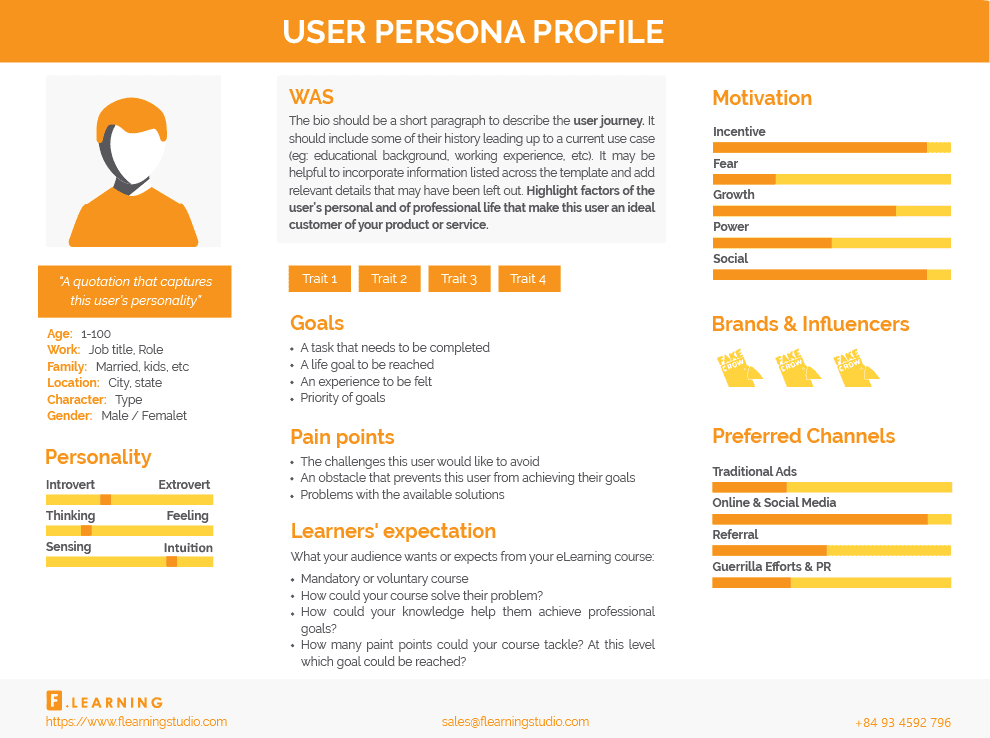You’re so certain about the great quality and effectiveness of your eLearning courses. But what if only a few learners know about those courses and the business does not reach sales targets as expected? Well, it’s time you should revise the marketing strategy for the courses. We recommend below a 5-step guide on how to market eLearning courses to gain success in the eLearning business.
How to market eLearning courses to success in 5 major steps
- Understand your learners
- Know your competitors
- Define price and revenue strategy
- Build the course’s brand
- Plan and run the marketing campaign
Let’s get into details.
Step 1: Understand your learners
Luckily you‘ve identified target learners at the very first stage of developing a successful eLearning course. That means you now have certain information about the potential learner persona, and you know what knowledge they need, how much free time they have, what kind of work/education they do, etc.
Yes, that information may help you to design the best-fitted eLearning courses for target learners. However, it’s not enough to help you to know how to approach customers, or how to market eLearning courses.
Understanding learners for eLearning marketing strategy requires you to look more at their pain points, motivators, influences, and online behaviors- For example do they use social media, or how much time do they spend on Facebook while on the Internet? The statistic lets you know whether advertisements on this site work for learners or not.
So, what you need to do here is collect a lot of information, summarize, and pick out the important ones. Then organize all the selected to create a complete profile of your potential learners.
TIPS:
Do not worry if you have no idea what to do. Below is an example of how F.Learning organizes learners’ information into a potential learner’s persona profile.
Step 2: Know your competitors
All businesses, including eLearning, face competition.
So, create a list of all competitors with their courses, prices, and what they offer and do not offer. You can also search for competitors’ recent activities to figure out how to better market training courses. Make the research as detailed as possible.
Based on that list, you’ll know how to take advantage of your competitors’ weaknesses in order to improve your business performance. In particular, you can define your course’s unique selling point or set a good price strategy compared to competitors. We will explain those in detail in the next steps.
TIPS: start a Google search of the course’s keywords if you’re just a beginner and unsure of who the competitors are.
Step 3: Define price and revenue strategy
As a business, you always have to think about keeping the bottom line profitable. How do you do that while there is so much free content available out there? Should you undercut competitors to gain a larger market share? Or you will offer a “premium” course to boost the revenue?
We know that makes you concerned a lot. Again, go back to the competitor spreadsheet and analyze the market prices, before building the price strategy. Remember to take other costs and factors into consideration, such as LMS management costs, material licenses, content production, etc.
And keep in mind that learners make their purchases for the content by analyzing the quality of the courses. So you do not have to, or should not, set a price just to compete with free ones.
TIPS:
Instead of lowering the price to gain more customers, consider the following tactics to leverage your courses and increase revenue:
– Offer complete access to an eLearning course and its update by a periodical subscription
– Offer special price for a group of learners
– Provide additional physical materials or hold private online events
Preparation Checklist to Power your Digital Transformation
Wondering if you miss anything in your preparation to digitize your training? This is just what you need.
Step 4: Build the course’s brand
Your biggest opportunity lies in what your competitors do not offer, in other words, in your unique selling points.
Think about key features and benefits that make your course special or different from others available. Figure them out, and highlight them as a consistent massage throughout its eLearning marketing strategy. They can be:
- Content: a detailed planning template, survey forms, or any knowledge or skills that no other courses offer;
- Unique features: interactive training modules or extensive resource library;
- Delivery methods: for example, a microlearning course that covers multiple compact lessons. This course type allows busy learners to complete their lessons one by one at their own pace;
- Special offers: free direct access to instructors during the course, or discounts for a follow-up course of higher training.
For example, a permaculture online course by F.Learning’s partner highlights its types and content delivery as unique selling points. We divide the whole course into smaller subtopics to make it easier to digest for learners. The content format combines both live-action for introduction parts and animations for scientific explanation parts.
Recommend reading:
Step 5: Plan and run the marketing campaign
Set specific goals
Never run your campaign to promote eLearning courses with no specific goals. You can’t determine if your program is successful without any KPI to target.
Additionally, with clear goals from the beginning, you can easily align initiatives to them. This helps you to stay on track while managing the campaign progress.
We recommend you establish goals that meet the SMART methodology, including Specific, Measurable, Achievable, Realistic, And Timely. Always make sure that they align with the organization’s overall goals and learning objectives.
Utilize all suitable channels
Here are some effective channels that can help you promote eLearning courses
- Use social media like Facebook, Youtube, Twitter to provide regular information. Do not forget to add relevant hashtags to optimize the search result.
- Make paid advertisements. It’s a great way to get the word out, although a bit costly.
- Boost your SEO with Google Ads
- Submit your courses on a marketplace, such as findcourses.com or candlefox.com
- Set up a community, online or offline, of your former, existing, and potential learners to remain connected with them. You can give further tips, organize live webinars, or even ask for reviews on these sites.
The more channels your course appears on, the more chances you can reach your target learners. Just remember to maintain the course’s brand compliance among all channels.
Provide a demo
It’s a great idea to leak a short preview from the actual course to get potential learners interested. You can upload those cut parts to Youtube, then share them on the website, Facebook, or Twitter.
Another way on how to market eLearning courses is to include a demo within the course introduction. For instance, see how we’ve included some remarkable scenes in the introduction animated video for IntelyCare.
Marketing audit
Marketing activities are something that you must always revise and improve on. Thus, it’s important to keep a record of the learner personas, strategy, and tactics. Then frequently assess them and find out how you can enhance their effectiveness.
For example, does the number of learners joining the course increase? Are they similar to the learner personas that you created?
A regular audit will let you see the weaknesses and the strengths of your marketing campaigns. Consequently, you’ll know how to improve your course and your business to make the most profit.
To sum up
No matter how good the courses are, eLearning marketing strategy plays an important part to make or break their success. Now you have a detailed to-do list on how to market eLearning courses. Go for it. F.Learning is here at every step of the way to support you!
Read more:

Sean Bui, the founder and creative director of F.Learning Studio, is a respected leader in the e-learning and multimedia production industry. With over 10 years of experience, he has dedicated his career to helping organizations create engaging and impactful learning experiences.
Under his leadership, F.Learning Studio has grown into a trusted partner for organizations in the education, healthcare, and corporate training sectors, producing over 2,000 minutes of educational animation.






